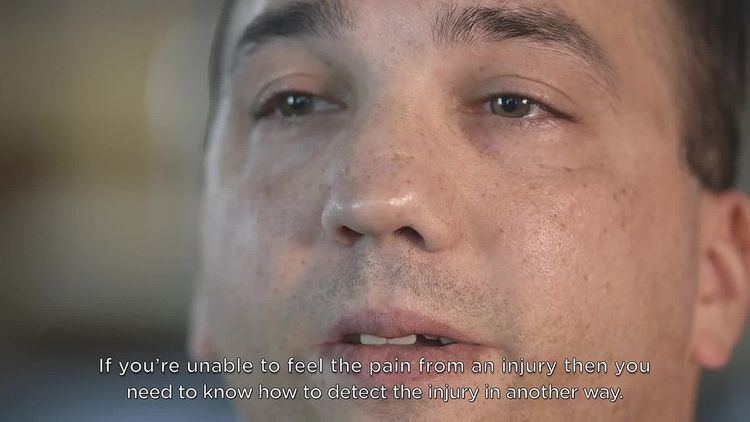OMIM 243000 147430 MeSH D000699 | DiseasesDB 31214 | |
 | ||
Congenital insensitivity to pain (CIP), also known as congenital analgesia, is one or more rare conditions in which a person cannot feel (and has never felt) physical pain. The conditions described here are separate from the HSAN group of disorders, which have more specific signs and etiology. It is an extremely dangerous condition.
Contents
Signs and symptoms
For people with this disorder, cognition and sensation are otherwise normal; for instance, patients can still feel discriminative touch (though not always temperature), and there are no detectable physical abnormalities.
Children with this condition often suffer oral cavity damage both in and around the oral cavity (such as having bitten off the tip of their tongue) or fractures to bones. Unnoticed infections and corneal damage due to foreign objects in the eye are also seen. Because the child cannot feel pain, they may not respond to problems, thus being at a higher risk of more severe diseases.
There are generally two types of non-response exhibited:
Causes
In some cases, the condition is caused by increased production of endorphins in the brain, in which case naloxone may be a treatment, but does not always work. In all cases, this disorder can be in the voltage-gated sodium channel SCN9A (Nav1.7). Patients with such mutations are congenitally insensitive to pain and lack other neuropathies. There are three mutations in SCN9A: W897X, located in the P-loop of domain 2; I767X, located in the S2 segment of domain 2; and S459X, located in the linker region between domains 1 and 2. This results in a truncated non-functional protein. Nav1.7 channels are expressed at high levels in nociceptive neurons of the dorsal root ganglia. As these channels are likely involved in the formation and propagation of action potentials in such neurons, it is expected that a loss of function mutation in SCN9A leads to abolished nociceptive pain propagation.
PRDM12 gene is normally switched on during the development of pain-sensing nerve cells. People with homozygous mutations of the PRDM12 gene experience congenital insensitivity to pain (CIP).
Developmental disabilities such as autism can include varying degrees of pain insensitivity as a sign. However, since these disorders are characterized by dysfunction of the sensory system in general, this specific condition is not in itself an indicator of any of these conditions.
Treatment
The opioid antagonist naloxone was recently found to allow a woman with congenital insensitivity to pain to experience it for the first time. Similar effects were observed in Nav1.7 null mice treated with naloxone. As such, opioid antagonists like naloxone and naltrexone may be effective in treating the condition.
Epidemiology
Congenital insensitivity to pain is found in Vittangi, a village in Kiruna Municipality in northern Sweden, where nearly 40 cases have been reported. A few Americans also have it.
In popular culture
In the Millennium series by Swedish author Stieg Larsson, the character Ronald Niedermann is presented as suffering from the condition, rendering him an overtly stereotypical henchman, which includes precipitating several plot devices in the series.
In the 2008 video game Dark Sector, protagonist Hayden Tenno suffers from this condition. This becomes a plot point when he is infected by a virus that drives most people insane due to the severe pain it causes in victims, which he is unable to feel.
In the season 3 episode of House M.D., "Insensitive", they treat a patient with the condition.
In the Japanese anime and BL game, DRAMAtical Murder, a supporting character named, Noiz suffers from this disorder. When he was younger, his parents considered him a disgrace because he would play rough with other children because he didn't understand what pain felt like. The only pain he could feel was from his tongue.
In season 3 of Perception U.S. TV series episode "Painless", there is a crime involving someone with the condition.
In season 3 of Grey's Anatomy (U.S. TV series) episode "Sometimes a fantasy", Dr. Alex Karev was treating a young girl with this condition.
